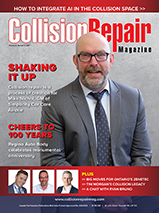ON TO THE NEXT
NEW NORMAL? NO PROBLEM
 If you recall, in last year’s Collision Repair Buyer’s Guide, we had cautioned that the 2020s would see the business of collision repair change beyond recognition.
If you recall, in last year’s Collision Repair Buyer’s Guide, we had cautioned that the 2020s would see the business of collision repair change beyond recognition.
Clearly, we were right.
This year brought far more chaos than anyone could have imagined. Sure, we’d expected the typical fast-paced changes alongside new technologies— but no one could have prepared us for the socially-distanced reality this year had to offer.
Don’t forget that this is only the beginning. There’s still far more to come, and the shift toward electric-powered and autonomous vehicle repairs could sneak up on you the same way 2020 snuck up on the world—should you have your back turned.
Canadian automakers have taken leaps and bounds in recent months to ensure that the nation is part of the new wave of automotive electrification. Quebec recently announced plans to cease the sale of gas-powered vehicles by 2035, while British Columbia plans to only sell zero-emissions vehicles by 2040.
Electrification is coming—fast. Along with it come a myriad of other expectations: new metals, continued OEM standards, consolidation—heck, the Canadian government has even teased wooden automotive parts. The future is upon us, and it’s time to react.
Come 2021, your business will face a choice—will you do whatever it takes to stay alive and thriving, or keel to the pressure of the new normal?
If you’re reading this, you already have your answer. You hold in your hand the very reason to be optimistic about the future of your business. Flip through the information-packed pages of this guide and embark on a path to success and profitability.
With information drawn from the resources of Collision Repair’s 20 years of publication, the 2021 Buyer’s Guide offers the most comprehensive overview of the top-notch products being used in the most forward-thinking collision repair centres. Moreover, the informed conversations with industry leaders, business owners, technicians packed between these pages— along with our daily eZine coverage and digital content—will guide you toward the right choices for you and your business.
Whatever the challenge, the 2021 Buyer’s Guide offers your solutions. This is the key to your business’ future—make sure you flip the ignition.





















